Honest Definition of Our Parental Fear
Impulsivity, short attention span, and inability to delay gratification are the symptoms of ADHD;
They are re-enforced in the child’s brain by too much screen time, and
It will ruin their lives, compromising education, career and relationships.
I have 2 boys with ADHD. They are obsessed with screens. These are our fears as their parents. It is personal. it’s our parental pain.
I try to address both the Problem and the Solutions – with the goal is to equip parents with actionable strategies.
The Problem
Children today are spending increasing amounts of time glued to their screens. Parents all over the world are becoming more concerned, and some of us have started calling this phenomenon by what it is: addiction. According to research by Common Sense Media, 50% of teens feel addicted to mobile devices, and 78% check their phones at least every hour. It’s no secret that most of us adults are becoming addicted to technology as well: 48% of adults feel the need to respond to texts and other notifications from their phones immediately.
Common Sense Census indicated that between all their devices, U.S. teens consume a staggering nine hours of digital media per day! The key conclusion of the study is that “even if children are not addicted, we should be cautious of the ways that problematic media use could affect their ability to stay focused or negatively impact their social and emotional well-being”. This Common Sense Media report was titled “New Report Finds Teens Feel Addicted to Their Phones, Causing Tension at Home” and it dates back to 2016. The situation has not improved since then – quite the opposite. A similar study conducted by Common Sense Media in 2019 in Mexico found that two-thirds of both teens and adults surveyed feel addicted to their mobile devices. The title of this newer report sounds almost hopeless: “The New Normal: Parents, Teens, and Devices Around the World”.
Research shows that digital media overuse leads to all kinds of negative consequences for our children: from compromised academic performance to the destruction of social skills, and from sleep deprivation to anxiety and depression.
But there is one particular group of children that is particularly vulnerable to digital addiction: children with ADD/ADHD (Attention Deficit/Attention Deficit Hyperactivity Disorder).
ADHD and Screens: Daily Parenting Reality
For parents of children with ADHD, screen time management is a daily struggle – your child cannot sit still for the 15 minutes of homework, but if you let him, will be hyper-focused for 12 hours straight playing video games!
And when you tell him time is up, all hell breaks loose. A child with ADHD will adamantly resist your efforts to impose limits on screen-time use. They fight back with a formidable weapon: Oppositional Defiant Disorder (ODD), which is another condition that often accompanies the initial ADHD diagnosis. According to DSM (Diagnostic and Statistical Manual of Mental Disorders) definition, what you get from this child is a pattern of defiant, angry, antagonistic, hostile, irritable, or vindictive behavior. For an unfortunate parent that experienced this, life becomes a battlefield.
The worst behavior is unleashed on the parent, and a good relationship with your child becomes collateral damage in the line of fire.
Peace and harmony is road kill.
How much easier it is to just hand over the iPad and experience hours and hours of parental peace, instead of constant power struggles and exhausting negotiations over screen time? Many a parent has been there. Parenting is difficult, and parenting a child with ADHD is plain exhausting. That child will not let you rest for a moment, demanding entertainment, breaking all kinds or rules and boundaries – unless their need for stimulation is fulfilled by the screen.
And – let’s face it – we are busy, and tired, and overwhelmed with a thousand obligations of our own (including more and more digital ones). Talking about temptation to give in! And maybe sometimes we have no choice but to engage in “electronic babysitting” for a while to give ourselves some breathing room. We just need to understand clearly that if we stretch that breathing room beyond an average of 2 hours of screen time per day for our child, experts have warned us about possible harmful consequences for their development.
Your child with ADHD had been quiet for hours playing on his iPad, and he is not interested in anything else – not playing outside, not reading, not spending time with real people. When you suspect that your child is becoming addicted to digital media to the point that intervention is required, they are unlikely to cooperate. Imagine what happens if an adult addict faces an intervention from a loving family and loses access to their drug/drink/behavior of choice?
You can expect resistance. Even violence.
Families of children with neurological diagnoses can have an especially difficult time trying to restrict their children’s screen time use. A child with the diagnosis that comes with lack of self-control as a symptom is ready to use anything – even physical force – against the parent, to pry the devices out of their hands to get their “digital drug” fix. And sometimes the child in question is a teenager, bigger and stronger than a parent. This can get ugly, and it happens more often than we think.
Tech tantrums (yes, it’s an actual term) by 3-year olds can be cute, 13-year olds – not so much.
Amy (name changed to protect privacy) loved her son with all her heart. He had several neurological diagnoses. He was spending too much time on his phone, which was making his symptoms worse. Late one night, Amy had to grab the phone out of his hands because her son refused to turn it off and go to bed. Angry with his mother, the next day the boy complained to his therapist – one of the many expensive treatments his parents paid for to get him the help he needed. He said his mother used physical force to take his phone away (a grown teenager, he was actually taller and physically stronger than his mother at the time of the incident). It just so happens, that despite medical confidentiality, the therapist – or anyone working with children – is legally obligated to report an incident to Child Protective Services if child abuse is even suspected. Better safe than sorry, not wanting to risk her license, that’s what the therapist did. Child Protective Services showed up at Amy’s door the next day throwing the family into horrific and humiliating investigation and threatening to take their children away – including the second child who did not have any neurological problems. The family was eventually cleared of all charges, but severely traumatized by the experience.
According to Dr. Russell A. Barkley, Ph.D., one of the leading scientists studying the disorder (see his advice for parents in his book, Taking Charge of ADHD), ADHD is a misnomer. It should have been called an executive functioning disorder, when a person’s prefrontal cortex does not do what it’s supposed to do – namely, self-control, responsibility, planning for the future, calculating the consequences of their actions, finishing important tasks – everything that they need to be a functional human being.
When a child with ADHD becomes addicted to technology, all they care about is instant gratification of that next computer game or YouTube video, here and now, easy and fun, an instant dopamine hit that both ADHD and addiction demand from them; homework and health and sleep and relationships and their whole future be damned! Only a functional prefrontal cortex can put a stop to this toxic loop, but guess what? That part of the brain is not there yet! Scientists tell us that this essential human hardware is not fully formed until age 25, and for children with ADHD, there is about a 30% delay in its development. So, according to Dr. Barkley, your ADHD child of 12 is really 8, biologically speaking.
And if they manage to get admission to college at 18, you are really sending a 12 year old to live in the dorm by themselves, manage their study schedule, and resist the temptations of college binge-drinking and promiscuous sexual behavior. Without some sort of external help and medication it could be a recipe for disaster. Now throw unlimited computer gaming into the mix without the parent to remind them to switch their attention back to schoolwork… and you just wasted tens of thousands of dollars in tuition because your kid dropped out of college and moved back home into your basement.
What is ADHD?
ADHD is a biological brain disorder, often genetic – a child is more likely to be diagnosed if one or both parents also has ADHD. Children with ADHD have trouble concentrating, finishing what they started, staying organized, managing emotions (particularly anger), thinking before they speak or act. While the causes of ADHD can be quite complex, it is generally believed that deficiency of the neurotransmitter dopamine in the brain is the main contributor. The dopamine loop is the reward system of the brain – when dopamine hits our neurons, it brings with it feelings of enjoyment and motivates us to repeat behaviors that resulted in the release of dopamine.
In a healthy brain, this can be a wonderful thing, designed by nature to reinforce behaviors that bring happiness and satisfaction to the individual. But for children with ADHD the same dopamine loop could trap them in a cycle of pursuing instant gratification – which in their world is easily achieved by playing fast-paced computer games and engaging in other online activities that provide an endless stream of perceived rewards. This digital obsession can and does often become a full-blown addiction. Let’s examine how and why.
What is Addiction?
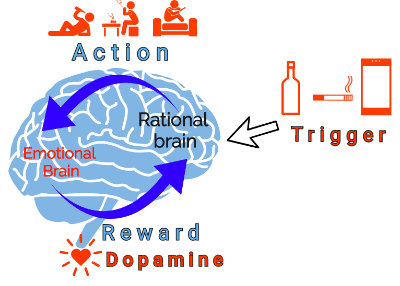
The biological mechanism of addiction involves the same chemical as the biological mechanism of ADHD – dopamine, which generates feelings of pleasure and satisfaction in the brain. Certain drugs, alcohol or behaviors stimulate dopamine production, the person experiences the sensation of pleasure, consumes more and more of the substance or repeats the behavior to get the same feeling, and eventually becomes addicted. The brain suffers long-term damage and is no longer capable of producing the same levels of dopamine from normal human activities. The pathway is formed, the brain is hijacked. To be happy, the person is now dependent on the substance or behavior they got addicted to.
So, the kid who started playing Fortnite after school for fun is now losing sleep, missing developmental milestones, destroying his academic performance and social relationships. The very ability to control his life is sacrificed to the new kind of addiction – internet gaming. The World Health Organization has recently included Gaming disorder in their official International Classification of Diseases. Internet Gaming Disorder is on its way to be included in the American Psychiatric Association’s Diagnostic and Statistical Manual of Mental Disorders (DSM). Internet addiction disorder is defined by the National Institutes of Health as any online-related, compulsive behavior which interferes with normal living. In short, digital media is officially on the list of addictions.
Playing Fortnite or taking meth is perceived by the brain as essentially the same. And like with any drug, with time the person needs larger and larger doses in order to get the same high. Computer games of today are faster, brighter, louder than computer games from a decade ago. Geared for the ever-decreasing attention span, and ever-increasing desire for stimulation and excitement. For some young adults, gaming addiction becomes such a big problem, that their families have to send them to a digital rehab center – a new and growing segment of rehab business.
Young people get hooked on gaming because the series of “small wins” built into computer games are intentionally designed to exploit the brain’s reward system by delivering a shot of dopamine to the pleasure centers of the brain, forming a habit. There is a disturbing ABC News report about the addictive nature of Fortnite, the most popular online multiplayer game. Parents in Quebec, Canada, actually filed a lawsuit against Epic Games Inc., the company behind the game, stating that it is as addictive as cocaine and ruins their children’s lives.
One does not need to be a cognitive scientist to see that an addiction for an ADHD brain is like putting gasoline on the fire. Indeed, research shows that people with ADHD are predisposed to addiction because ADHD by definition impairs impulse control.
The areas of the brain that are used the most and get the most stimulation are getting stronger – like the muscles that get stronger with training. Constant stimulation of the dopamine loop mechanism that is already malfunctioning because of ADHD enforces the very behavior that a child – and later adult with ADHD – needs to overcome in order to have a normal life. In the past these behaviors were smoking, drinking, drug use, gambling and other forms of “traditional” addictions. In the present, internet gaming and digital media overuse hijack the same brain passages as drugs and alcohol.
Another fact is that exposure to digital media happens a lot earlier than a first chance to smoke and drink, usually before the age of two – and that’s a big problem.
What research shows is that the earlier in life the person becomes addicted to anything, the harder it is to break that addiction later in life. The person who started smoking or drinking or taking drugs as a teenager would have a much harder time trying to break the addiction as an adult. The brain passages that formed in a developing brain associate pleasure with the drug (or other substances and behaviors), and it’s much more difficult to change this biology once the person grows up. Their brain was formed under the influence of addictive substance or behavior before it had the chance to fully grow and mature.
Addiction becomes biologically hardwired in the brain – and it’s not something that can be surgically cut off, like a tumor.
Do Screens Make ADHD Symptoms Worse?
The question many parents contemplate is, does screen time make ADHD symptoms worse? The rapid-fire action of fast-paced shows and video games seems to synchronize perfectly with the ADHD brain that craves overstimulation. Although the child seems to be focused, it’s not the same kind of attention they need to function and succeed in real life. A video game requires short bursts of attention rapidly switching from task to task, with no time to stop and think. It rewards them with points, tokens, prizes, monsters killed – every few seconds, providing instant gratification and the illusion of progress.
Dopamine hits are constant, and all happen within the shortened attention span of ADHD. No wonder kids with ADHD find computer games so appealing.
With video games being so pleasurable and stimulating, children with ADHD may find it harder to concentrate on tasks in the normal circumstances that require sustained attention, long time to accomplish, might be boring, and do not provide rewards until much later when the task is complete.
According to the 2012 study by Iowa State University researchers, children who are already more impulsive or have attention problems tend to spend more time playing video games, which may make their attention problems worse. What is interesting is that it was not the content of the video games (such as violence) that had the most negative effect on attention, but the overall time children spent gaming. According to this study, playing computer games does not cause ADHD. The causes of ADHD are genetic and biological. However, there is enough compelling evidence to suggest that excessive amounts of screen time make ADHD symptoms worse.
Parents may not be scientists, but we notice that after a long time on the screen kids’ behavior goes downhill, and their ADHD symptoms become worse than usual. And now the science is catching up with parental common sense: a new study out of the University of Alberta has found that by the age of 5, children who spent two hours or more looking at a screen each day were “five times more likely to exhibit clinically significant behavioral problems such as inattention, acting out, hyperactivity and being oppositional; and over seven times more likely to meet the criteria for attention deficit hyperactivity disorder” than preschoolers who spent less than 30 minutes per day.
Another study published in the Journal of the American Medical Association in 2018 looked at 2,500 high-school students in California, who were 15 to 16 years of age and had high amounts of screen time, especially social media. Researchers found that teens who used digital media many times per day and already had an ADHD diagnosis, experienced an increase in symptoms, while kids without ADHD developed ADHD-like symptoms after two years of frequent digital media use. On the last point the connection was controversial and statistically small, but significant enough to cause concern – can children somehow acquire this environmental form of ADHD even if they did not have it biologically? According to the study, “Mid-adolescence is a period of high neural plasticity during which brain circuitry underlying attention and behavioral control mature rapidly and may be vulnerable to exposures that disrupt neurodevelopment”.
Researchers seem to suggest here that young people’s brains are being biologically rewired by high frequency digital media. The study concludes that more research is needed.
These growing human beings are effectively reprogrammed for shorter attention spans, lack of self control, difficulty sustaining attention, hyperactivity, and impulsivity – all the classic markers of ADHD.
John Ratey, an associate professor of psychiatry at Harvard Medical School, an expert on ADD, and the author of the best-selling book “Delivered from Distraction – Getting the Most Out of Life with Attention Deficit Disorder” said he noticed that the symptoms of his ADD patients and people with smartphones are “absolutely the same”. “We’re not developing the attention muscles in our brain nearly as much as we used to,” he said.
It seems, our whole society displays ADHD symptoms driven by overuse of technology. Our lives are taken over by digital media, and it has us frazzled, overwhelmed, rapidly switching from task to task and not committing to anything in a deep meaningful way. As author Steven Pressfield said, we are all “a river a mile wide and an inch deep”.
Real-Life Consequences for ADHD+Digital Media Addiction
Academic performance goes downhill
The constant stimuli of the online world does not require the child with ADHD to work hard to sustain attention. Video games make the task easy with all the lights and noises and prizes. Very satisfying – and very different from real life. So, a child with ADHD feels increasingly uncomfortable in the real world and craves escape into the virtual reality of online gaming. The pull of the game overrides the sense of responsibility to work hard on their education. Homework is rushed through or forgotten altogether, and academic performance goes downhill.
Social skills are not developed
Social skills is another problem for children with ADHD, mainly due to their impulsivity – speaking and acting without first thinking of the consequences. The social cost of impulsive behavior can be high. Although our public schools have made remarkable progress in the prevention of bullying, children can still be cruel and unforgiving when it comes to social mistakes.
Your immature impulsive child with ADHD will not be attacked, he will be… politely ignored. Excluded. Avoided.
Well, that is not much of a problem within the artificial social circles of video games, where there is neither face-to-face contact, nor non-verbal feedback for bad behavior. There is an equally artificial sense of connection and belonging that the child may lack in real life. With more time spent in gaming chats, children with ADHD have less opportunity to practice real-world communication skills which are already underdeveloped due to their condition.
Physical health is compromised
Studies also show that regular physical activity reduces the severity of ADHD symptoms. The only physical activity required for gaming is moving the thumbs on the game controller, the only reason to get up is to walk to the pantry without taking your eyes off the iPad, to reach in for more chips! Hence, our impulsive, immature and oppositional kids with ADHD are also unhealthy and obese.
Sleep deprivation is detrimental for any brain, and for ADHD brain especially so. It can be difficult for a child with ADHD to calm down and go to sleep, and being overstimulated with screen time before bed does not help. Oftentimes, children with ADHD have to take stimulant medications like Vyvanse for their condition. It helps them concentrate at school, but it is an amphetamine – a controlled substance, illegal without a prescription. Common side effects include trouble sleeping – in position number one.
Remember, the street name for amphetamine is “speed”.
“Anything you say can and will be used against you”
Another dangerous side effect of impulsivity that comes with ADHD: these children are more likely to engage in risky behaviors online and/or be exposed to inappropriate content. Kids with ADHD are not fully equipped to think about the risks of sharing their personal information with strangers online, which makes them more vulnerable to predators. They can also impulsively post their own questionable content, and ruin their reputations forever.
Teenagers have always made stupid mistakes. That is what makes them teenagers, and is developmentally normal – their brains are not fully developed yet to calculate long-term consequences of their actions, and at the same time they are actively trying to break away from the control of their parents and assert themselves in the world as their own person. Of course, they screw up. Teenagers have done it for hundreds of years, in every generation, and eventually grew out of it. It’s what growing up is all about – learning from your mistakes.
But these days teenagers leave a permanent record of their mistakes online, and their mess-ups are increasingly criminalized. The cost can be high: a mistake from teenage years can derail the rest of their life. Once something is posted on the Internet, it takes a life of its own and cannot be erased. It does not belong to you anymore. And guess what – society does not accept “I didn’t mean it!” as an excuse. Mean remarks online can result in a bullying label and expulsion from school. Sexting can earn teenagers a permanent sex offender record – both boys and girls. Jokes about weapons and shootings can result in an actual arrest and a criminal record. Here is a story about how sharing inappropriate memes cost 10 students their Harvard admission.
Colleges and prospective employers will Google you and check your Facebook profile – and if they see anything they don’t like, you are not going to be accepted or hired, even if reputation-compromising content was posted decades earlier. The conclusion is clear – anything you say online can and will be used against you. That’s what the police is required to tell the person being arrested. The safest behavior at that point is to remain silent and not incriminate yourself. Except when the offense had been committed online, it’s too late to remain silent. You are already condemned.
So What are You to Do as a Parent?
Unfortunately, there is no easy way around it – it is your job to be your child’s prefrontal cortex.
Yes, it is likely that you will not have a life of your own, but if you love them, you have no other choice. YOU NEED TO BUY THEM TIME TO GIVE THEIR BRAIN A CHANCE TO MATURE. Lack of self-control is a symptom when it comes to ADHD, and as much as you want your child to learn to make their own wise choices, until their brain catches up, chances are you have to do it for them. Your children will not impose screen time limits on themselves voluntarily. If you do not install some form of healthy boundaries on screen time, they will be playing computer games until their brains boil, forgetting to eat and sleep and go to the bathroom. Homework? What homework?!
Once you impose screen time limits, assume good intent initially, but remember that ADHD is not your friend. Expect your child to sabotage your efforts and lie, cheat and steal to get their devices back. It’s not their fault, they cannot adequately plan for the future because of their diagnosis.
Imagine, you leave a full cookie jar in your pantry and tell them that you will give them one cookie per day (or 1 hour of screen time per day). The next day you discover that the cookie jar is empty (they are on their phone in their bedroom at 2am on a school night). How many times does this need to happen before you remove the cookie jar (take the phone away)?
Would professional therapy help manage your child’s screen time addiction? Maybe. But Cognitive Behavioral Therapy (CBT) – a very effective form of therapy that normally works well for difficult behaviors – instructs their therapists to disclose that it may have limited effect on a child with ADHD. That’s what the therapist told us when we took our son to see her. She said that typically the child will agree with the therapist during the session – and promptly forget everything they talked about, because the ADHD prefrontal cortex is not equipped to retain and retrieve this information to self-regulate their behavior. In fact, the therapist recommended that a parent, not a child, would attend the sessions and be trained on the techniques for encouraging good behaviors and discouraging bad ones. There seems to be no way out from doing the hard work of parenting! Bummer.
There are many ways to put an effective screen-time management system in place in your home (see the section Solutions on our website). It is particularly important to do it when your child has been diagnosed with ADHD, because – let’s face it – you need to protect them from themselves.
Tools and Strategies for ADHD Screen Time Management
For a child with a neurological diagnosis, screen-time management needs to be an external form of help, and as such it falls within the category of assistive technology. Assistive Technology (AT) is defined as any equipment or software designed to help people overcome challenges or disabilities so they can learn, communicate, and function better. An audiobook is assistive technology for someone with dyslexia. A wheelchair is AT for people with mobility issues. Your day planner is assistive technology for organizing your life. Smartphone apps assist us in everything these days – from meditation to – ironically, screen time management.
Children with ADHD need a crutch for their ability to self-regulate, which is impaired or non-existent. Yes, their self-control needs crutches. Because it’s broken. A person with a broken leg cannot walk without crutches, and we don’t expect them to. For parents of children with special needs, removing the temptation for digital media overuse through effective screen time management techniques is a much more realistic strategy than expecting these kids to do it on their own. Expectations to resist the digital drug on their own would be unfair, and would lead to unnecessary conflict and damage to the relationship.
- Establish family rules to limit screen time for your child. For example, screen time only starts after all homework and chores are completed (and after the parent has performed quality control!), and is limited to one or two hours a day. American Academy of Pediatrics Family Media Plan tool is an excellent place to start. There are a lot of great books on the subject of screen time management.
- Time management and organizational skills are not the strong suit for a child with ADHD. So, write down a detailed schedule for them listing all activities they need to complete before and after school, micromanaged down to “brush your teeth” and “make your bed” level, and use it as a guide to structure their day and keep them organized. “Yes, you can have your iPad as soon as A, B and C on your list are completed”.
- Use a timer and multiple warnings to ease transitions off screens and reduce tech tantrums. Build in screen time breaks to prevent overstimulation (chances are your KIDS will set the timer to make sure those breaks do not exceed the pre-agreed time!).
- Enable screen-free alternatives. Kids pick up a book or head outside to play when screens are off!
- Spend time doing things together! You may need to devote more time to your children than parents ever did in the past, but take them on trips, to museums, games, theatres, bike rides, hikes, restaurants, amusement parks, beaches, farms, gym, you name it! You may feel like you don’t have any time for yourself, but isn’t quality time with your child worth it?
- Keep them busy doing better stuff! In my personal experience, overscheduling kids with extracurricular activities works really well despite its bad reputation! After all, if all they want to do in their free time is stare at screens, the less free time the better.
- Use passwords, parental controls, screen time management apps and screen time management devices. There are many choices, please see the Solutions section on our website.
- Control distractions during homework. Phones should be put away, TV or any other devices should be turned off. If the child is doing homework on the computer (most likely these days), check that he/she is not playing online games or watching YouTube videos instead. We have a chromebook devoted exclusively to homework, where everything but Google classroom is blocked. We also requested paper-based homework from school, when available, and regularly update the school on distractions we catch so the school could block them.
- Enforce tech-free downtime an hour before bedtime. Remove devices at night to prevent unauthorized use when the rest of the family is sleeping – yes, it happens quite often.
- Know what they do on their screens and make sure they know that you know! Perform random inspections to make sure they are behaving safely online and are not exposed to inappropriate content. Put content filters in place on all devices kids use. Use a reliable monitoring software.
- Keep all tech in a common area, like the living room or the kitchen. Do not put computers or TVs in kids’ bedrooms, and take phones away at night.
Conclusion: Digital Addiction Risk Factors
Risk factor #1: Young brain
It is much harder to break an addiction if it has been formed at a young age.
Solutions: Delay giving your child a smartphone as long as possible. Wait Untill 8th campaign encourages parents to wait until at least 8th grade before giving children a smartphone. Use a dumb phone if necessary. Limit the amount of total screen time spent across devices.
Risk factor #2: ADHD diagnosis
People with ADHD are predisposed for addiction. A child with ADHD is more likely to become addicted to substances or behaviors, including addiction to digital media.
Solutions: Limit the time your child spends on addictive screen-time activities like computer games. 2 hours a day seems to be the most recommended upper limit. Be vigilant – check regularly that your child does not develop workarounds to break your screen-time rules and steal screen time behind your back.
Risk factor #3: Addictive technology
Digital media is intentionally designed to be addictive to exploit the weaknesses of the human brain to maximize screen time. By doing this, tech companies extract the maximum amount of value from the individual by exposing them to advertising and collecting their data for sale.
Solutions: Not all screen time is created equal. Games like Fortnite are extremely addictive – limit those, and encourage your child to play more educational and less violent games. Turn off notifications on all the apps, they are there to hijack attention and make your child grab their phone and respond immediately. Limit social media channels your child uses to one or two – or nothing if they are younger. Place daily time limits on the apps to prevent obsessive binging on particular digital media like Snapchat. Remove autoplay on YouTube and Netflix.
Parents are the only defense our children have against the “digital heroin” that ruins their lives. We need to resist the dangers of digital media to protect them.
Take Back Control
Sign up for our monthly newsletter to receive latest digital wellbeing research and screen time management solutions. We never share your email with third parties.Footnotes and sources:
Common Sense Media: www.commonsensemedia.org
American Academy of Pediatrics: www.aap.org
American Psychiatric Association: www.psychiatry.org
Dr Russell A. Barkley, Ph.D.: www.russellbarkley.org
World Health Organization: www.who.int
National Institutes of Health: www.nih.gov
Children and Adults with Attention-Deficit/Hyperactivity Disorder (CHADD): www.chadd.org
Assistive Technology Industry Association: www.atia.org
Image credits: www.unsplash.com, www.logomakr.com

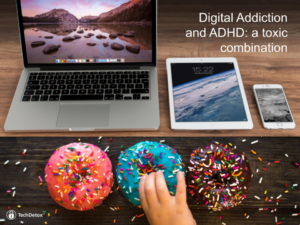




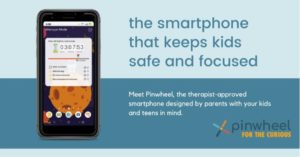

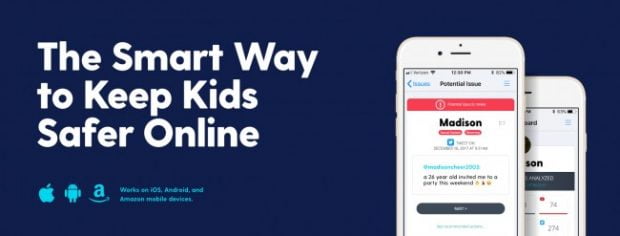

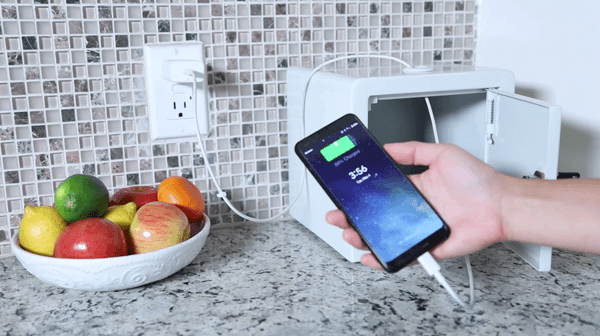
Wow I have not even thought about a lot of this before. What a cool, informative article! Thanks.
My god this is spot on and nails exactly what my family has been suffering from. Thank you for publishing this article. It is sad to think of how many poor kids have been lost as a result of this going unchecked.
Yeah I’m one of those poor kids who has been lost to unchecked adhd. All I did in college was be on my pc and skip class and drink alcohol. Now i’m 29 no job no friends no relationships ever and 30000 hours in an online game.
Such a wonderful article. Spot on. I recently lost my younger brother. he suffered from ADHD. As he navigated adulthood he became more addicted to his phone and developed a secret gambling addiction. Was successful in some areas of his life but struggled emotionally and with impulse control. His ADHD was managed but poorly. He developed comborbid depression because of the toll his addictions (screen/gambling) had on his brain. Out of shame and guilt, he compulsively lied to cover his issues. After blowing through all his money and 401 K his girlfriend left him and he took his life. ADHD is no joke. My brother was not raised with screens and cellphones. He developed the addiction as the technology advanced. The gambling is scary as hell for ADHDers. 20% of compulsive gamblers have ADHD. And 20% of compulsive gamblers commit suicide. So tragic and not discussed enough. So grateful this site is putting out such good content regarding screen/technology use.